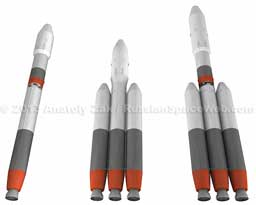Tuesday 13 June 2017
Russia, Kazakhstan to Step Up Funding of Soyuz-5 LV Project
Keywords:
BAIKONUR (Interfax) — Russia and Kazakhstan have coordinated a program of the financing and accelerated creation of the Soyuz-5 LV and relevant launch infrastructure at the Baikonur cosmodrome, Russian Deputy Prime Minister Dmitry Rogozin said.

- Soyuz 5 family
- Three variations of the Soyuz-5 rocket as of 2013 and 2014. Each module of the first stage would be equipped with a single RD-0164 engine burning liquid methane. An upper stage would feature RD-0124 engine modified for methane fuel and developing a thrust of 30 tons.
Despite severe cuts in its space budget at the end of 2015, the Russian government gave the go ahead to the development of a new launcher family, which could finally replace the legendary Soyuz rockets after seven decades in service. Moreover, the new rocket is also positioned as a steppingstone toward the super-heavy booster to carry a next-generation manned spacecraft into deep space.
Russian officials did not hide the fact that the latest move was prompted in part by the competition from the US-based SpaceX company. “[…] Competitors are already stepping on our heels, look what’s billionaire (Elon) Musk is doing with its projects!” Russian Deputy Prime Minister Dmitry Rogozin told the Vesti TV channel on Dec. 30, 2015, adding: “We are treating his work with respect and we are studying and analyzing it in detail [...]we are looking for solutions which will make our space launches much cheaper and these solutions will be found […] to maintain our leadership in the launch (services) market.”
In September 2016, Roskosmos awarded a 809 mln ruble ($12.66 mln) contract to KBKhA, which would fund the development of the methane engine until the end of 2018. The contract called for the development and testing of a demo engine with a thrust of 7.5 tons, followed by tests of the experimental engine with a thrust of 40 tons. In turn, it would pave the way for the development of an engine prototype with a thrust of 85 tons.
From the outset of the project, engineers hoped to cut the time for the on-pad preparation from two days for old Soyuz rockets to just one day for Soyuz-5.
Soyuz-5 could use modified launch facilities of the Soyuz family. However a major departure of the Soyuz-5 design from the classic cone-shaped architecture of Soyuz rockets toward a more traditional cylindrical design will likely mean that the iconic “tulip” structures of the launch pad would have to go.
As of 2013, a pair of Soyuz pads operated in Baikonur, a total of four Soyuz launch pads once existed at Russia’s northern launch site in Plesetsk, and one pad was operational at the European space centre in Kourou, French Guiana. One more pad is under construction in Vostochny in the Russian Far East.

